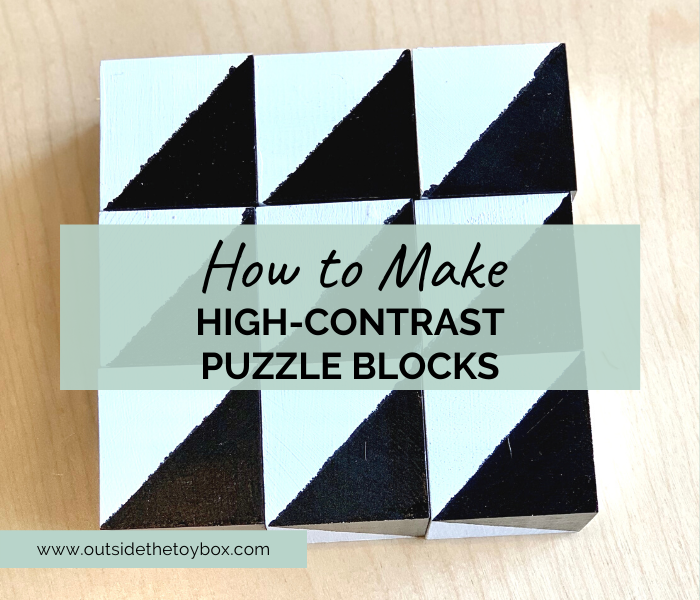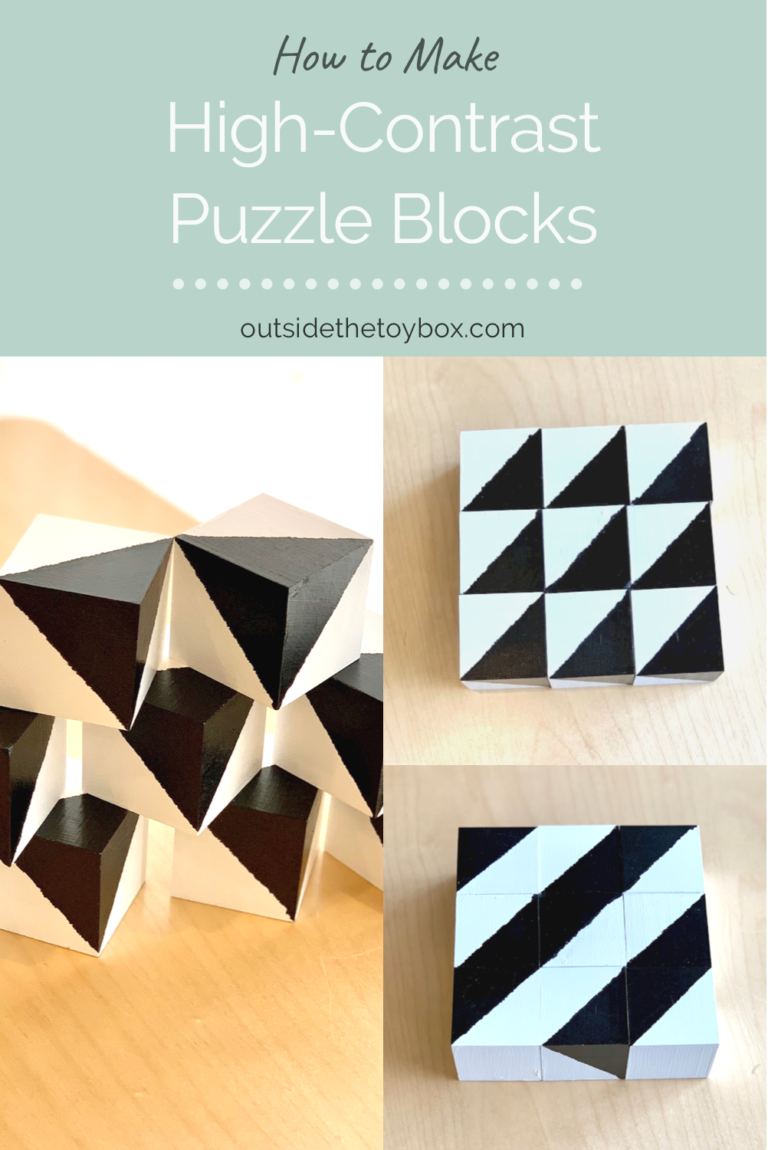If the pandemic has you feeling like exploring new or old hobbies or you just feel like getting a little crafty, let me suggest these high contrast puzzle blocks. They are a great DIY project for babies and beyond.
The black and white nature of the blocks are great for young babies, but you don’t have to put them away after the newborn phase is over. They are created so they can be a really fun puzzle to create multiple designs for kids of any age (even I had fun seeing how many designs I could create).
These blocks are amazingly versatile and beneficial for babies through preschoolers. After reading this you will definitely want to create some of your own high contrast puzzle blocks.
Disclosure: This post may contain affiliate links, which means we may receive a commission if you click a link and purchase something that we have recommended. As an Amazon Associate, I earn from qualifying purchases at no cost to you. Please check out our disclosure policy for more details.

Benefits
Benefits for Babies
You may have seen baby toys and books galore with only black and white images and wondered why. Don’t you want to teach them about color and make their toys more interesting to look at?
Well, for very young babies (0-3 months) they do not have the visual capacity to see defined colors. They see shadows and things very close to them (Babies 3-6 months only see about 12-15 inches in front of them). Since they don’t see all the shades and hues of color that we see, the time to teach about color is not now.
By simplifying their toys it helps them to concentrate on the object and improves their focus. Many toys for babies and young children are overly complicated. The belief is that the more elements they put on a toy, the longer the child will engage. That is simply not the truth, especially for babies.
A simplified toy with high contrasting colors like black and white will help them to visually discriminate the patterns, design, and colors. This supports their memory and attention span. They also make for a great sensory play resource.
A toy with lots of colors, patterns, sounds, things hanging to and fro will likely overwhelm a small child and they will lose interest quickly.
Benefits for Toddlers
I have noticed that Ruby (currently 20 months) hasn’t really shown much interest in stacking with blocks. I thought for sure this was something every toddler loved to do. I provided her with foam blocks, natural tree branch blocks, smaller one inch blocks, and I only ever saw her stacking a few times.
I was in the middle of creating these DIY high-contrast puzzle blocks and she came over and immediately stacked all 9 blocks to form a tall tower. Wow!
I didn’t even know she was capable of stacking that high. Then I realized all the blocks I had provided for her were not suitable for wobbly little toddler hands. The awesome thing about these blocks is they are two inch cubes, which makes stacking a whole lot easier.
I saw her face go from extreme focus to pride as she created that tower. I knew that providing her with the tools she needed was the missing piece of the puzzle.
Benefits for Preschoolers
The way these DIY high-contrast puzzle blocks are created allows for multiple ways to create. There is not just one way to finish this puzzle, which allows for much more open-ended play.
Open-ended play is beneficial for all children, but especially for preschoolers who are developing their creative thinking and problem solving skills. Since there is no wrong answer, these puzzle blocks really promote self-confidence. The young child takes risks and tries new ways to create if they know there is little to no chance of getting it “wrong.”
They have to think in 3 dimensions and rotate the blocks to problem solve. They begin to learn about the cube.
I really had fun challenging myself with building as many designs as I could. Children will also love creating and building with these high-contrast puzzle blocks.
Check out my other DIY projects
4 Super Engaging Cardboard DIY Projects for Toddlers
Quick, Easy, and Affordable DIY Light Table
How to Make Montessori Tactile Numbers for Only $1
Materials
Since babies and toddlers will be using these blocks and most likely putting them in their mouths, it’s important to use durable, non-toxic, and non choke hazard materials. There isn’t really a paint or finish that is food grade because paint is not supposed to be edible. So, in my research, I learned that shellac (especially the shellac flakes) are the next best option as far as safe for putting in their mouths.
These were the materials I used:
- Craftsmart acrylic paint
- Painter’s tape (I used masking tape, but it didn’t come out as straight as I would like. Painter’s tape is probably better)
- Foam paintbrush
- 2” wooden cubes
- Shellac for finishing (there are some other options for finishing that I will link below)
shop this DIY




Non-toxic finishing options




Process
Before
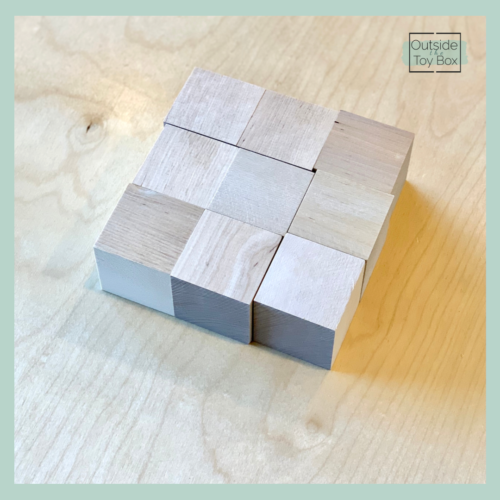
These blocks are beautiful even unfinished and not painted. I might get some more just for natural wooden blocks.
Step One
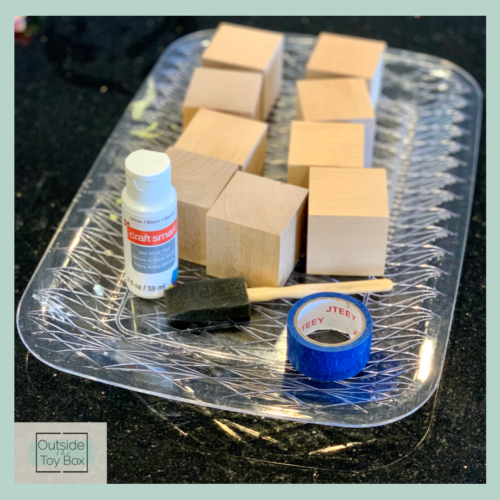
First, I painted all the blocks completely white. I added about 2-3 coats for full coverage.
Step two
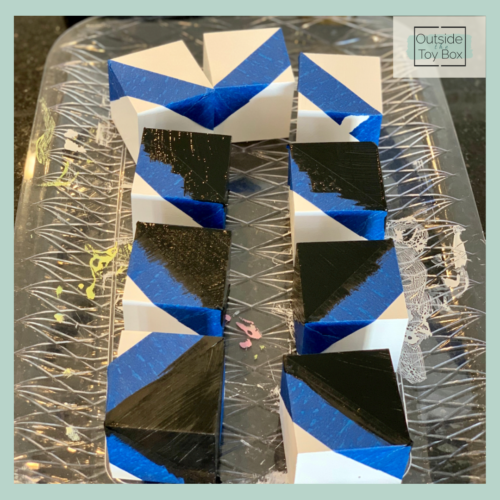
Next, I used tape to create a diagonal straight edge. My edges did not come out perfectly straight so I would suggest painter’s tape or a different method to create a completely straight edge.
I kind of like the jagged look though. It gives it a personal touch and looks more homemade.
Step Three
Then I painted one corner of the blocks black. This also took about 2-3 coats for full coverage. This took a little while because you have to wait until the paint is fully dry in-between coats. Luckily, acrylic paint dries quickly.
Step Four
After waiting for the paint to fully dry, I took off the tape. I touched up any really bad spots. Then I added the shellac to seal the paint.
After
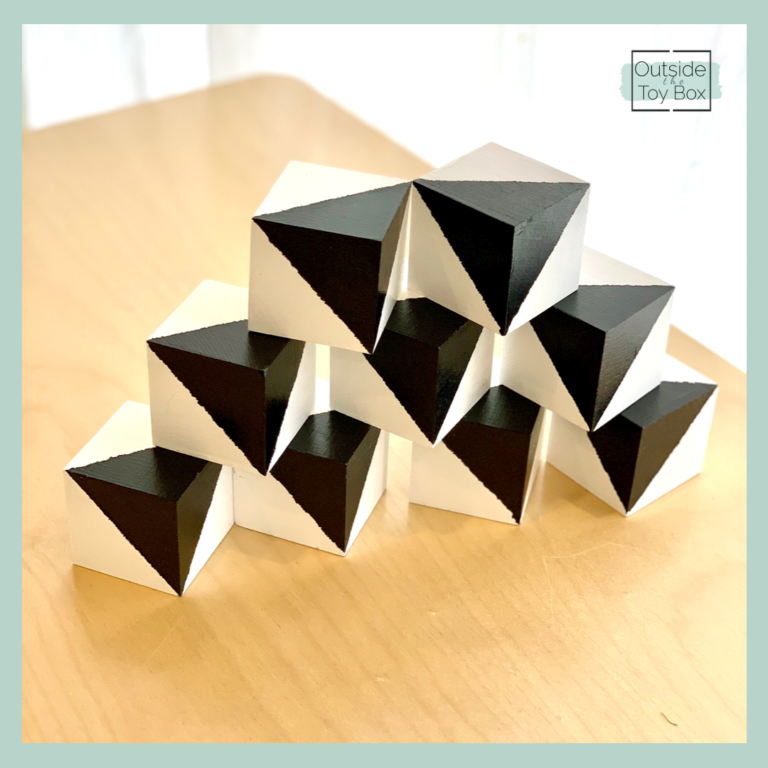
How to Play
Babies
These DIY high-contrast puzzle blocks are great for creating interest during tummy time. You may begin tummy time from just a few weeks old, but they may not lift their heads for a couple months. Building a pattern or simply showing one or two blocks will encourage your young baby to lift their head and engage their muscles to extend their play time.
I actually created these blocks to include in Miles’ (3 months old) Easter Basket. See what else I included and get more Easter Basket ideas for babies and toddlers HERE.
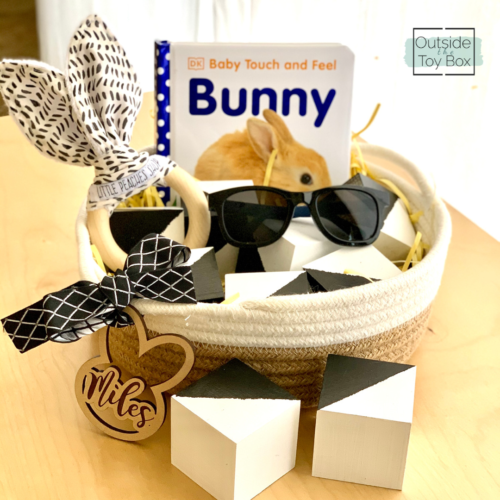
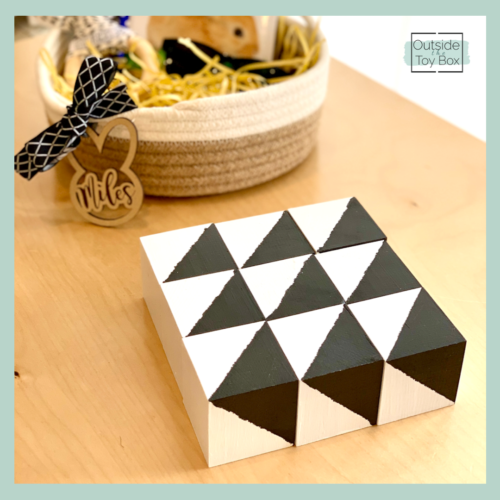
Toddlers
Toddlers will begin to use these blocks for stacking. They are the perfect size for little hands. They do not fall down easily, so there is a larger margin of error for toddlers that do not have the best hand eye coordination.
Check out the focus and determination on Ruby’s face as she builds:
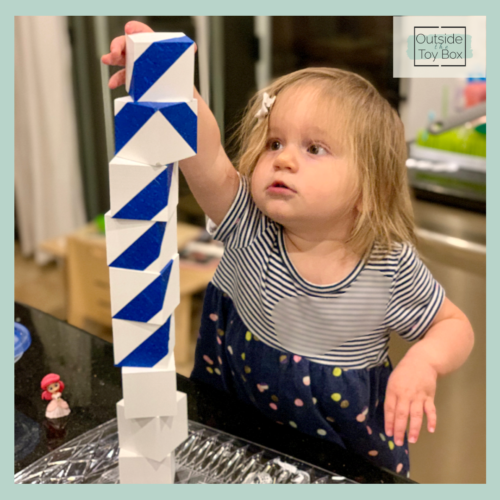
Preschoolers
Preschoolers will use these high-contrast blocks to create designs. They will turn, match, rotate, and create. You can challenge them to see how many different patterns they can create.
Some of the Designs I created
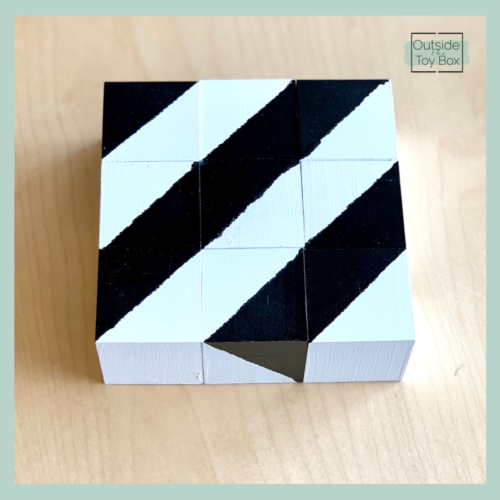
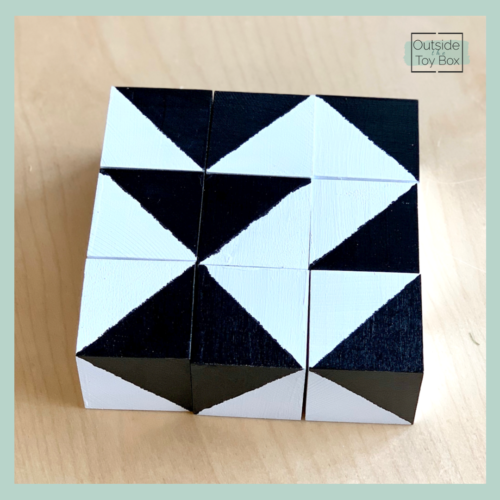
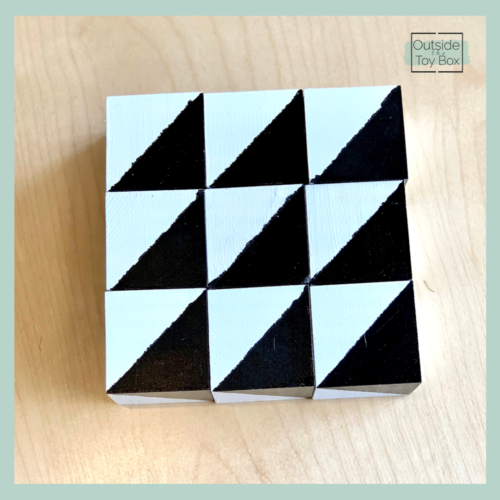
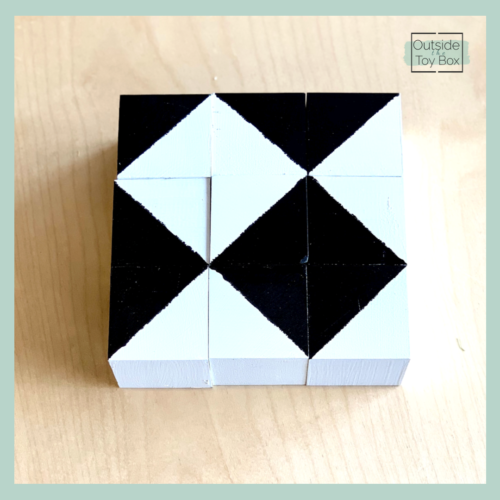
Check out more DIY Projects
4 Super Engaging Cardboard DIY Projects for Toddlers
Quick, Easy, and Affordable DIY Light Table
How to Make Montessori Tactile Numbers for Only $1
Make sure you save this idea for later
on Pinterest
Follow us on Social Media to get daily play inspiration.
Facebook
Instagram
Pinterest

Share on facebook
Facebook
Share on pinterest
Pinterest
Share on email
Email
Share on print
Print
Please help to support my blogging efforts by sharing this post to others who may find some value in its contents.

